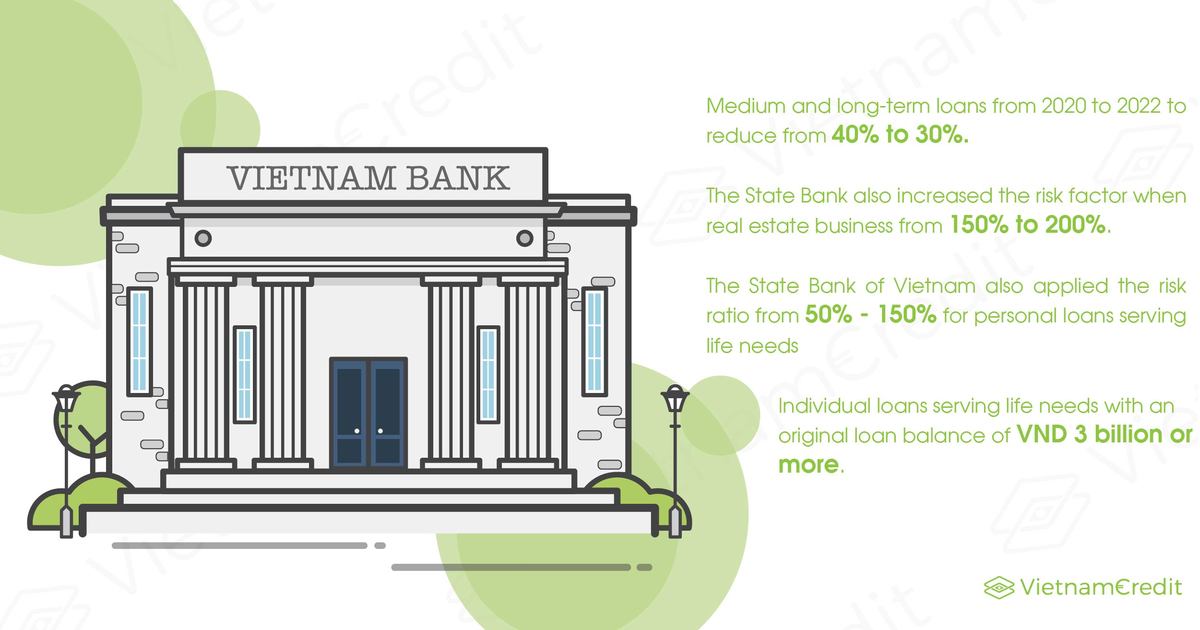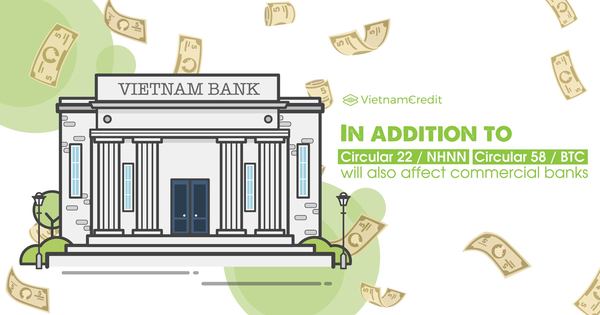The group of state-owned commercial banks is expected to be greatly affected by the new regulations.
Recently, the State Bank of Vietnam (SBV) has issued Circular No. 22, which stipulates limits and prudential ratios in the operations of banks and bank branches in Vietnam.
In particular, the operator has set a roadmap to gradually tighten the maximum rate of short-term capital sources used for medium and long-term loans from 2020 to 2022 to reduce from 40% to 30%. In addition to reducing the ratio of short-term capital for medium and long-term loans, the State Bank also increased the risk factor when real estate business from 150% to 200%.
The State Bank of Vietnam also applied the risk ratio from 50% - 150% for personal loans serving life needs, in which, for individual loans serving life needs with an original loan balance of VND 3 billion or more, it has to bear the highest risk coefficient in the framework.

Circular 22 aims to ensure more safety for the system, but it will gradually tighten the operations of banks, causing difficulties for many banks in the coming time.
At the same time, a regulation is also said to affect the operations of banks, especially state-owned commercial banks, which is Circular No. 58 of the Ministry of Finance which takes effect from November 1st, 2019.
Specifically, Circular 58/2019 / TT-BTC on management and use of accounts of the State Treasury opened at the State Bank and commercial banks prescribed, from November 1, 2019, Vietnam officially applies Treasury Single Account (TSA).
In simple terms, if the Government used to borrow debt by issuing bonds to collect money back, if the money has not been disbursed, the State Treasury may deposit it at commercial banks and owners, mainly in the group of State-owned commercial banks, Circular 58 now requires that the money must be collected to an account of the State Treasury located at the State Bank of Vietnam Exchange. That is, the SBV will act as a manager of money and debt for the Government.
In addition, previously, both the tax revenue can be kept in the collection/payment accounts of the State Treasury at commercial banks for up to several weeks (without interest). Currently, with the new regulation, at the end of the day, it must be transferred to TSA at the State Bank, and the next day it will be released according to the spending plan.
According to calculations by Dr. Pham The Anh, in recent years, with the process of disbursement of public investment extremely slowly, the above-mentioned idle amount has reached over VND 200,000 billion and is a great benefit for commercial banks with a State Treasury account.
Our aggregate reality through the financial statements of banks also shows that, in 2017, the amount of State Treasury deposits at commercial banks amounted to 236,000 billion. At the end of 2018, in only three banks, Vietcombank, BIDV, and VietinBank, the balance of the Treasury amounted to VND 216,000 billion, besides that, a large amount of money was also deposited in private joint-stock banks such as MB. By the end of the first 9 months of 2019, the State Treasury's deposit balance at major banks continued to be stable at over VND 200,000 billion.
Assuming that the interest rate margin is about 3%, commercial banks are estimated to have about VND 6,000 billion profit from this cash flow.
But now, the money must be transferred to the State Bank and commercial banks will no longer benefit. Although Circular 58 does not require all treasury deposits to be transferred to the SBV focal point immediately (term deposits will wait until maturity), the movement of this giant cash flow will certainly affect the operation of the banks.
"In the past few years, the liquidity of the banking system has been extremely good, interbank interest rates have sometimes dropped to about 1-2% partly due to the Government's idle money in commercial banks. In addition, the continuous purchase of foreign exchange (about 30 billion USD in the last 3 years) has also caused the amount of money in the system to skyrocket. The SBV must issue bills to withdraw the excess money. Now with the application of TSA, the system liquidity will be significantly reduced "- Dr. Pham The Anh assessed one of the effects of applying Circular 58.
And the fact that recent developments in the interbank market also show that the State Treasury withdraws money at commercial banks, combined with seasonal factors, the demand for payment at the end of the year has partly affected the system liquidity. The situation was "heavier" in the week immediately following the interest rate lowering action of the State Bank on November 19. Within a week, the interbank interest rate doubled and by November 26 the SBV had to intervene by sharply lowering the lending interest rate through the open market (OMO) to pump cheap capital at 4%. / year (instead of the previous 4.5%) for banks. The agency must also net inject money into the system continuously. Until November 27, the interbank interest rate just reversed to decrease but remained at a high level compared to the past few months.
But any policy will have two-way effects and the policy to be implemented often has more advantages than disadvantages. In addition to impacting on commercial banks in the direction of cutting off profits gained by the "treasury" of the State Treasury, Circular 58 is also assessed to have many benefits.
It not only helps the monetary policy operator to have closer cooperation from fiscal policy, to increase the initiative in capturing and balancing the amount when regulating capital in the system every day but also can be free to buy more foreign currencies.
However, according to expert Pham The Anh, there are also certain concerns. “By adopting TSA, the SBV has now become the cash flow manager and debt manager, even the last lender to the Government. This can not help worrying about the confusion between monetary policy and fiscal policy, or the concern of "monetizing" public debts when the SBV does not have the independence, does not publish the balance sheet as other central banks in the world” - he said. Therefore, for Circular 58 to be an effective tool to contribute to a more effective monetary policy, it requires the SBV to be extremely skillful in operating.
























































